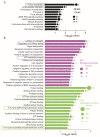High Stretch Modulates cAMP/ATP Level in Association with Purine Metabolism via miRNA-mRNA Interactions in Cultured Human Airway Smooth Muscle Cells
- PMID: 38247802
- PMCID: PMC10813996
- DOI: 10.3390/cells13020110
High Stretch Modulates cAMP/ATP Level in Association with Purine Metabolism via miRNA-mRNA Interactions in Cultured Human Airway Smooth Muscle Cells
Abstract
High stretch (>10% strain) of airway smooth muscle cells (ASMCs) due to mechanical ventilation (MV) is postulated to contribute to ventilator-induced lung injury (VILI), but the underlying mechanisms remain largely unknown. We hypothesized that ASMCs may respond to high stretch via regulatory miRNA-mRNA interactions, and thus we aimed to identify high stretch-responsive cellular events and related regulating miRNA-mRNA interactions in cultured human ASMCs with/without high stretch. RNA-Seq analysis of whole genome-wide miRNAs revealed 12 miRNAs differentially expressed (DE) in response to high stretch (7 up and 5 down, fold change >2), which target 283 DE-mRNAs as identified by a parallel mRNA sequencing and bioinformatics analysis. The KEGG and GO analysis further indicated that purine metabolism was the first enriched event in the cells during high stretch, which was linked to miR-370-5p-PDE4D/AK7. Since PDE4D/AK7 have been previously linked to cAMP/ATP metabolism in lung diseases and now to miR-370-5p in ASMCs, we thus evaluated the effect of high stretch on the cAMP/ATP level inside ASMCs. The results demonstrated that high stretch modulated the cAMP/ATP levels inside ASMCs, which could be largely abolished by miR-370-5p mimics. Together, these findings indicate that miR-370-5p-PDE4D/AK7 mediated high stretch-induced modulation of cAMP and ATP synthesis inside ASMCs. Furthermore, such interactive miRNA-mRNA pairs may provide new insights for the discovery of effective biomarkers/therapeutic targets for the diagnosis and treatment of VILI and other MV-associated respiratory diseases.
Keywords: airway smooth muscle cells; high stretch; microRNA; purine metabolism; ventilator-induced lung injury.
Conflict of interest statement
The authors declare no conflict of interest.
Figures






Similar articles
-
MircroRNA Let-7a-5p in Airway Smooth Muscle Cells is Most Responsive to High Stretch in Association With Cell Mechanics Modulation.Front Physiol. 2022 Mar 25;13:830406. doi: 10.3389/fphys.2022.830406. eCollection 2022. Front Physiol. 2022. PMID: 35399286 Free PMC article.
-
Mechanical Ventilation-Related High Stretch Mainly Induces Endoplasmic Reticulum Stress and Thus Mediates Inflammation Response in Cultured Human Primary Airway Smooth Muscle Cells.Int J Mol Sci. 2023 Feb 14;24(4):3811. doi: 10.3390/ijms24043811. Int J Mol Sci. 2023. PMID: 36835223 Free PMC article.
-
High Stretch Associated with Mechanical Ventilation Promotes Piezo1-Mediated Migration of Airway Smooth Muscle Cells.Int J Mol Sci. 2024 Feb 1;25(3):1748. doi: 10.3390/ijms25031748. Int J Mol Sci. 2024. PMID: 38339025 Free PMC article.
-
circ_CSNK1E modulates airway smooth muscle cells proliferation and migration via miR-34a-5p/VAMP2 axis in asthma.Cell Signal. 2022 Jul;95:110340. doi: 10.1016/j.cellsig.2022.110340. Epub 2022 Apr 26. Cell Signal. 2022. PMID: 35483563
-
MicroRNA-638 inhibits human airway smooth muscle cell proliferation and migration through targeting cyclin D1 and NOR1.J Cell Physiol. 2018 Jan;234(1):369-381. doi: 10.1002/jcp.26930. Epub 2018 Aug 4. J Cell Physiol. 2018. PMID: 30076719 Free PMC article. Review.
References
-
- Retamal J., Hurtado D., Villarroel N., Bruhn A., Bugedo G., Amato M.B.P., Costa E.L.V., Hedenstierna G., Larsson A., Borges J.B. Does regional lung strain correlate with regional inflammation in acute respiratory distress syndrome during nonprotective ventilation? An experimental porcine study. Crit. Care Med. 2018;46:e591–e599. doi: 10.1097/CCM.0000000000003072. - DOI - PubMed
Publication types
MeSH terms
Substances
Grants and funding
LinkOut - more resources
Full Text Sources

